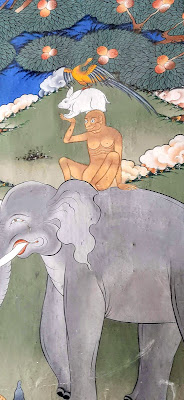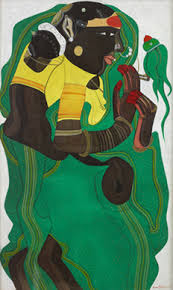Just at a stone’s throw from Punakha Dzong, 15 to 20 minutes’ walk to
be more precise, we have the longest suspension bridge of Bhutan spanning 170
m. Originally built by Thangthong Gelopo
in the 15th century, it was reinforced in the 17th
century soon after the Dzong was
built. The idea was to provide quick access for the villagers of Punakha valley to the Fort as it was the
administrative HQ of Bhutan. The bridge sways and by the time you reach the
middle, you get a feeling of being in a cradle! It’s a nice feeling, the Phochhu River flowing underneath, strong
winds rocking the cradle and the greenery around! Time for nostalgia. A subtle
feeling of loss, that is! However, the other side is bit of a disappointment. A
few jobless youths idling away by the huge prayer wheel at the landing. And the
family that runs a bar desperately waiting for customers…
 |
| The longest suspension bridge of Bhutan |
After lunch, it was time to
visit the Fertility Temple or Chimi Lakhang. In fact we had heard
quite a lot about the ‘Divine Madman’ Drukpa Kunley (1455 – 1529). The Lakhang (temple) was built in 1499 in
honour of the maverick saint. Lama Kunley
was quite unorthodox in teaching Buddhism employing humour and ‘outrageous
behaviour’ as tools! The paintings and statues of the Crazy Saint are in plenty and he looks an angry young man in spite of possessing “magic thunderbolt of
wisdom”! He advocated the use of phallic symbols in paintings and carvings to
drive away the ‘evil eye’. In order to reach his abode, one must take a difficult
ride through the muddy road surrounded by paddy fields. After reaching the
monastery one has to undertake a short trek to reach the Lakhang. All houses in the village have phallus paintings on their
exterior walls. The twenty minutes trek path is lined with makeshift merchandise
spread on the ground on both sides selling wooden replica of erect penises and
paraphernalia with the same as the main icon!
 |
| The puja offerings are in strange shapes! |
The original phallus that Kunley brought from Tibet is kept at the
Lakhang. The main priest blesses you
with the wooden, ten inch phallus decorated with a handle made of bone. He touches
your head with it. Women seeking divine intervention to beget children
patiently wait for their turn. Some of them carry wooden phalluses around the
perimeter of the Lakhang in order to
boost their chances of conception!
We sat under the majestic Bodhi tree in front of the temple with a
raised platform around it and watched the proceedings in silence. Many of the
visitors were seated on the ground enjoying the cool breeze from the fields. It
was time to leave and I couldn’t help asking Karma about the pathetic condition
of the road. It was a well-frequented thoroughfare and the only access to the lakhang. Karma was forthright in his
answer. He squarely put the blame on politicians. The people are being punished
for favouring the opposition party! Actually it should not have happened as
Bhutan has an almost fool-proof system of the election process.
Primary elections are held in
which voters cast for parties. The top two parties are then able to field
candidates in the main round across the country’s twenty districts. They must
field candidates for every constituency throughout the country. The party that
commands the majority in the 47 seat parliament named National Assembly will
put forward its leader as PM nominee. Three elections are over in Bhutan making
a change each time at the top. The joke is that the manifestoes of the three
parties are strikingly similar and the voter is unable to decide! The main
players are, Bhutan Peace & Prosperity Party (DPT), Peoples Democratic
Party (PDP) and Druk Namrup Tshogpa
(DNT).
The next morning, on the fourth
day, we drove towards Phobjikha, at a
distance of two-and-a-half hours from Punakha.
If you consider progress in terms of well-laid roads, high-rise buildings and
state-of-the-art machine floors, Phobjikha
is a primitive place. Only peasants live there cultivating potato, wheat,
millets etc. and rearing cattle. Worries like the lack of connectivity and
absence of infrastructure didn’t seem to have troubled them. However, the
government on its part have introduced skill enhancement schemes such as lodge management,
tourist guide training etc. for additional income generation. Phobjikha valley is officially declared
as conservation area. The Black-necked
Cranes visit the valley twice a year flying all the way from Tibet! The
valley has a special event, the Crane
Festival, to celebrate the event during November.
 |
| The cattle and their owners of Phobjikha valley have no complaints! |
The Government has instituted
a Crane Information Centre atop a
small hill which not only disseminates info but takes care of injured cranes
too. We have had a good look at one such Karma,
a juvenile black-necked crane found injured in the valley on 6th
Jan.2016. Karma the bird was not very
happy with the new bunch of onlookers intruding its privacy and we were surely getting
on its nerves! Immediately we made a quick retreat to watch a home-made
documentary at the mini-auditorium. The opening scene was that of the migrating
cranes circumambulating the monastery Gangtey
at the Phobjikha valley. They were
bidding farewell to Bhutan for the season. During winter the cranes land up
from Tibet encircling the Monastery three times on arrival too! The documentary
says the villagers consider the black-necked cranes as harbingers of luck and
the birds turn up every year with clock-work precision! Later on, when we
visited the Gangtey Monastery we
checked this fact with the monks and found it to be true. They also said the
annual Crane Festival was being conducted at the Monastery on 11th
November every year.
Known by the name of the
village, Gangtey Monastery is the
oldest monastery in Bhutan (established in 1613). The woodwork is 450 years old
and is prone to beetle-larvae infestation. The landscape is marshy with high
content of moisture in the air. No wonder the grand monastery is perpetually
under repair. The most recent renovation was carried out continuously from 2001
to 2008. When we reached the place,
fresh bout of maintenance was going on and the workers had stopped the work for
a short while to attend the prayers. We entered the main hall and didn’t feel
like sitting there for long. The place was quite stuffy with practically no
ventilation and the noise level was too high. The monks, mostly the younger
ones were beating their strange looking drums mercilessly.
 |
| The most popular painting of Bhutan - "Four Friends" |
A mural named “The Four
Friends” seemed to be the only consolation. In fact, the painting is quite
ubiquitous in Bhutan. Monasteries, lakhangs and even commercial
establishments have a copy of “Four Friends” painted on the wall. It’s about an
elephant, a monkey, a rabbit and a bird pondering over a fruit dangling from a
nearby tree. The lumbering elephant wouldn’t get the fruit without monkey’s
help despite its great bulk. If the bird didn’t eat the fruit and excreted
seeds into ground, the tree wouldn’t exist. And the tree would bear no fruit if
the rabbit didn’t protect the root underground!
In short, the mural is about
the interdependence of things in nature. The accent is on living in harmony with
it.
(contd.)
*************
